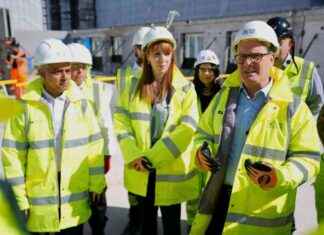In Marseille, Tuesday, January 31, the police counted 40,000 demonstrators against the pension reform, the CGT 205,000. In Nantes, they were 28,000 according to the police, 65,000 according to the unions. The science of crowd counting is subtle and all the more complex during demonstrations, which are by definition in motion and characterized by variations in density. Why such a discrepancy in numbers? Le Monde takes stock of the methods used by the police, the unions, or the independent firm Occurrence.
A manual count for the police
The counting done by the police is done manually, by “clicking” using a counter, activated each time a dozen people pass. It is carried out by “dedicated personnel” who are generally placed on a high point, “a few hundred meters from the place of departure” of the demonstration, specifies the Ministry of the Interior.
A second high point can be set up “halfway through the course” for larger mobilizations, continues Place Beauvau. In addition, the police can record a demonstration and carry out a subsequent recount after viewing the videos.
Estimates for unions
On the union side, counting is done manually with purely human means. Activists placed along the procession count the lines of demonstrators one by one. “They estimate by eye how many people there are per line, and they multiply those two numbers,” Franceinfo explains.
Call for technology for an independent firm
Since 2017, an independent count has been set up by the firm Occurrence, which provides the figures recorded during the demonstrations to a media collective, of which Le Monde is a part.
Occurrence uses “Eurecam” technology, used in particular for “security missions, in airports or fanzones”, summarizes its president, Assaël Adary, with Le Monde. Sensors placed on the passage of the procession create a field with a virtual line. Everyone who crosses this line is counted by these sensors.
The movement of people in demonstrations being more complex than in a fanzone for a sporting event, with for example differences in density or visibility, there is a margin of error which can be 30% to 40%, according to Mr. Adary. However, this margin of error is corrected with “manual micro-counts”, especially when the density is high, or when an element, such as a smoke bomb, disturbs the visibility.
“When we recount, it is almost systematically to add” demonstrators, said the president of the cabinet: “We communicate to the media at the end of the demonstrations a kind of spreadsheet where we see the figures, observed in increments of eight seconds, with the number given by the sensor, and the corrected number. »
Out of forty demonstrations, the figures recorded by Occurrence were between 15% and 20% above those recorded by the prefectures, and between 220% and 250% below the figures communicated by the unions.
Which method is more reliable?
Can we determine which method comes closest to reality? A commission tried to answer it in 2014. Dominique Schnapper, director of studies at the Ecole des Hautes Etudes en Sciences Sociales (EHESS), Pierre Muller, Inspector General of INSEE, and Daniel Gaxie, professor of political science , were commissioned by the Paris police headquarters to study the best way to count.
Despite an “inevitable margin of error”, these three figures concluded that the system employed by the police was the least flawed. The authors of the study nevertheless recommended that the police communicate a range rather than a precise number. In addition, the study, published in 2015, did not take into account the methods of the firm Occurrence, whose independent counting was launched in 2017.






